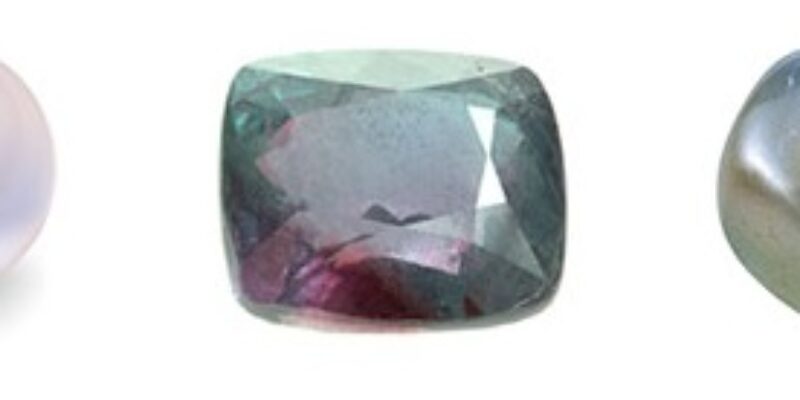
June – the Month of Pearl, Moonstone, and Alexandrite
Leave your thoughtsPearl History

Pearls have been used as adornment for centuries, at least as far back as ancient Greece, where they believed pearls were the tears of the gods. The oldest known pearl jewelry was discovered in the sarcophagus of a Persian princess who died in 520 BC. During the Byzantine Empire, rules dictated that only the emperor was allowed to wear these treasured gemstones, and ancient Egyptians were often buried with their prized pearls.
Tudor England was known as the Pearl Age because of the stone’s popularity with the upper class during the sixteenth century. Portraits showed royals wearing pearl jewelry and clothing adorned with pearls. In the early 1900s when the first commercial culturing of saltwater pearls began in Asia, pearls became more accessible. Since the 1920s, cultured pearls have almost completely replaced natural pearls in the market.
The name “pearl” comes from the Old French perle, from the Latin perna meaning “leg”, referencing the leg-of-mutton shape of an open mollusk shell. Because perfectly round, smooth, natural pearls are so uncommon, the word “pearl” can refer to anything rare and valuable. The rarest and most expensive pearls are natural pearls made in the wild without human interference. The majority of pearls sold today are cultured or farmed by implanting a grafted piece of shell (and sometimes a round bead) into pearl oysters or freshwater pearl mussels.
Pearl Facts
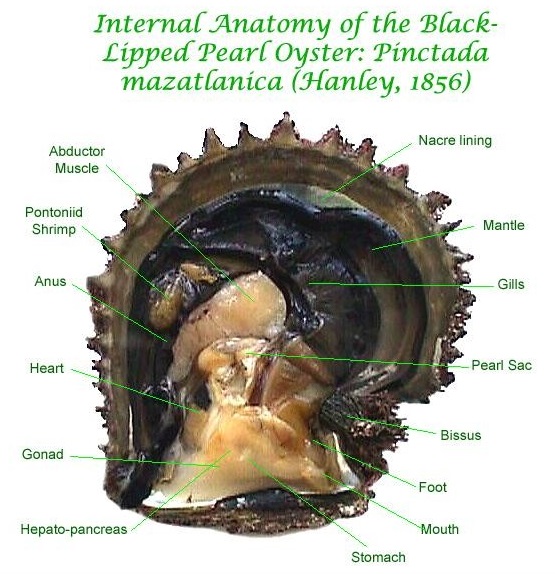
Pearls are the only gemstones made by living creatures. Mollusks produce pearls by depositing layers of calcium carbonate around microscopic irritants—usually a grain of sand, as it’s commonly believed—that lodge in their shells. While any shelled mollusk can technically make a pearl, only two groups of bivalve mollusks (or clams) use mother-of-pearl to create the iridescent “nacreous” pearls that are valued in jewelry. More Pearl Facts.
The finest pearls have a naturally reflective luster, making them appear creamy white with an iridescent sheen that casts many colorful hues. Cultured freshwater pearls can also be dyed yellow, green, blue, brown, pink, purple or black. Black pearls—which are mostly cultured because they are so rare in nature—aren’t actually black but rather green, purple, blue or silver.
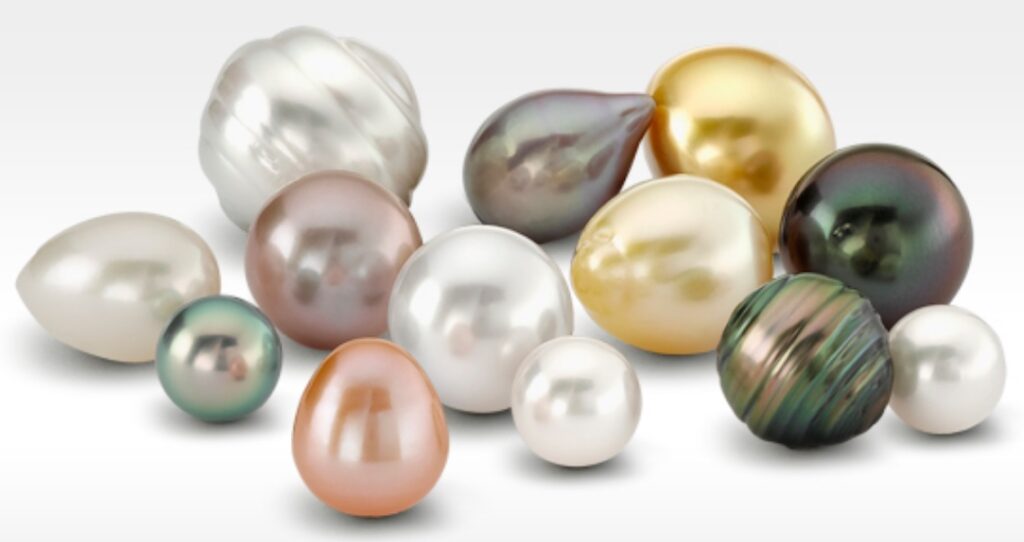
Source: Winterson U.K. Website
Pearls used to be found in many parts of the world, but natural pearling is now confined to the Persian Gulf waters near Bahrain. Australia owns one of the world’s last remaining pearl diving fleets and still harvests natural pearls from the Indian Ocean. South Sea pearls are cultured along the northwestern coastline of Australia, the Philippines, and Indonesia. Today, most freshwater cultured pearls come from China.
Pearls range in size from 3 to 13mm. Beware of imitation pearls or shell pearls, which are made from conch shells or glass coated with a solution containing fish scales. Rubbing two pearls together will reveal if they are smooth imitation stones or if they feel gritty from the nacre that comprises natural and cultured pearls.
Moonstone History
June’s second birthstone, moonstone, was named by the Roman natural historian Pliny, who wrote that moonstone’s shimmery appearance shifted with the phases of the moon. The Romans admired it, believing it was formed from moonbeams. Both the Romans and the Greeks associated moonstone with their lunar deities.
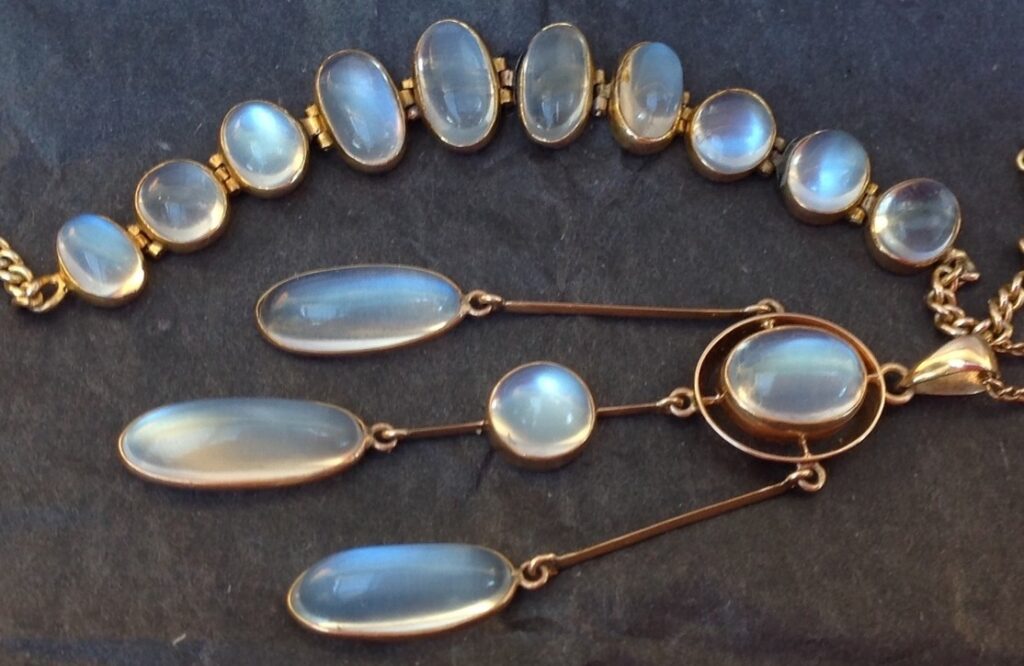
When Art Nouveau became popular between 1890 and 1910, designers featured moonstone in custom jewelry. It was also featured in handcrafted silver items during the last half of the nineteenth century in the Arts and Crafts era. Moonstone continued to be popular with hippies in the 1960s and designers in the New Age movement of the 1990s.
Florida adopted moonstone as its official state gemstone in 1970 to commemorate the Apollo 11 moon landing and other spaceflights that launched from Florida—even though moonstone is not naturally found in Florida or on the moon.
The most common moonstone comes from the mineral adularia, named for an early mining site near Mt. Adular in Switzerland that supplied this gemstone. The site also birthed the term adularescence, which refers to the stone’s milky glow, like moonlight floating on water.
Moonstone Facts
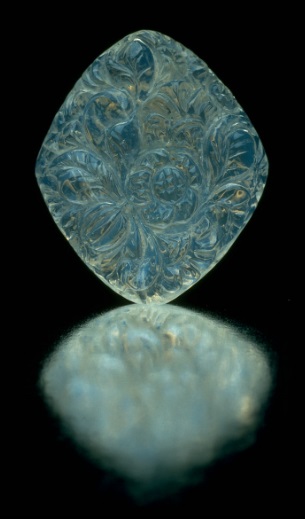
Moonstone is composed of microscopic layers of feldspar that scatter light to cause this billowy effect of adularescence. Thinner layers produce a bluish sheen, and thicker layers look white. Moonstone gems range in colors from yellow, gray, green, blue, peach, to pink, sometimes displaying a “star” or “cat’s eye”.
The finest classical moonstones, colorlessly transparent with a blue shimmer, come from Sri Lanka. Since these sources of high-quality blue moonstones have essentially been mined out, prices have risen sharply. Moonstones are also found in India, Australia, Myanmar, Madagascar, and the United States. Indian gemstones, which are brown, green, or orange in color, are more abundant and affordably priced than their classical blue counterparts.
Alexandrite
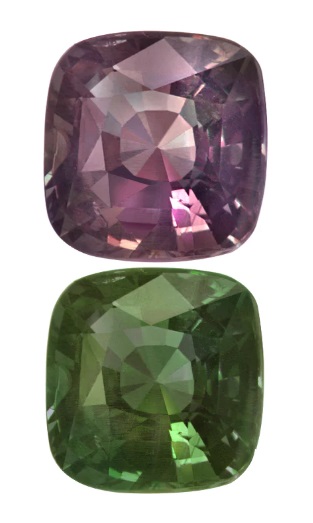
Often described as “emerald by day, ruby by night”, alexandrite is a rare variety of the mineral chrysoberyl that changes color from bluish green in daylight to purplish red under incandescent light. This chameleon-like color shift is the result of its uncommon chemical composition which includes traces of chromium, the same coloring agent found in emerald. These elements combining under the right conditions make alexandrite one of the rarest and most expensive gemstones on Earth. It was first discovered in emerald mines near the Tokovaya River in the Ural Mountains. Its Finnish discoverer initially mistook it for emerald before realizing it changed colors under different light sources.
According to legend, this gemstone was named for Alexander II because it was discovered on the future czar’s birthday in 1834. Because alexandrite’s red and green hues matched Russia’s military colors, it became the official gemstone of Imperial Russia’s Tsardom.
With a hardness of 8.5 on the Mohs scale, alexandrite is softer than sapphire and harder than garnet—the other gemstones that can change color. However, due to its scarcity, alexandrite is more valuable than most gemstones, including rubies and diamonds. More on Alexandrite.
The Pearl and Moonstone Birthstones
Pearls make the perfect gift for babies born in June or under the signs of Gemini or Cancer. As ancient symbols of purity and innocence, pearls are traditionally worn by a bride on her wedding day.
Moonstone, valued for centuries is still popular and accessible today. It’s the preferred June birthstone over pearl and alexandrite, in parts of the world like Germany and Scandinavia. Classical moonstones are cut as cabochons with a high dome to accentuate the adularescence. Large blue moonstones (over 15 carats) are rare, but stones with silvery-white adularescence are available in sizes up to hundreds of carats.
Pearl and Moonstone Care
Pearls are very soft, ranging between 2.5 and 4.5 on the Mohs scale. They are sensitive to extreme heat and acidity. Calcium carbonate is so susceptible to acid that authentic pearls will dissolve in vinegar. They should be cleaned with a mild soapy solution and never polished.
In addition to being a birthstone for June, pearls are traditionally presented as gifts to commemorate the 1st, 3rd, 12th, or 30th wedding anniversaries.
Moonstone’s weakness is its relatively low hardness of 6 on the Mohs scale, making it prone to stress cracking and cleaving. Care is required with moonstone jewelry like rings or bracelets; so, sometimes brooches and pendants are preferred for long term durability.
In addition to being a birthstone for June, moonstones are traditionally presented as gifts to commemorate the 13th wedding anniversary.

